Eco-Friendly Synthesis of 1H-benzo[d]imidazole Derivatives by ZnO NPs Characterization, DFT Studies, Antioxidant and Insilico Studies
Abstract
:1. Introduction
2. Results and Discussion
2.1. Chemistry
2.2. ZnO- NPs Examination
2.2.1. XRD Examinations
2.2.2. Morphological and Elemental Analyses (EDX)
2.2.3. Zeta Potential
2.3. Antioxidant Evaluation
2.4. Insilico Studies
2.4.1. Molecular Docking (Antioxidant)
2.4.2. Pharmacokinetiks
Molinsipration
3. Experimental
3.1. General Procedure for the Synthesis of 2-Substituted 1H-Benzimidazoles 2(a–g)
3.1.1. 2-(1H-Benzo[d]imidazol-2-yl) Phenol (2a)
3.1.2. 2-(Thiophen-2-yl)-1H-benzo[d]imidazole (2b)
3.1.3. 2-(Naphthalen-1-yl)-1H-benzo[d]imidazole (2c)
3.1.4. 2-(4-Chlorophenyl)-1H-benzo[d]imidazole (2d)
3.1.5. 2-(4-Nitrophenyl)-1H-benzo[d]imidazole (2e)
3.1.6. 4-(1H-benzo[d]imidazol-2-yl) Benzonitrile (2f)
3.1.7. 4-(1H-benzo[d]imidazol-2-yl)-2-methoxyphenol (2g)
3.1.8. 4-(1H-benzo[d]imidazol-2-yl) Benzoic Acid (3)
3.1.9. Ethyl 4-(1H-benzo[d]imidazol-2-yl) Benzoate (4)
3.1.10. 4-(1H-benzo[d]imidazol-2-yl)benzohydrazide (5)
3.2. Preparation of ZnO
Characterization of the ZnO
3.3. DPPH Radical Scavenging Activity
Antioxidant Evaluation
3.4. Insilico Studies
3.4.1. Molecular Docking (Antioxidant)
3.4.2. Assessment of Pharmacokinetic Properties
3.4.3. Molinspiration
Bioavailability Radar
Physicochemical Properties
Lipophilicity
Water Solubility
Pharmacokinetics
3.5. Computational Details
Structural Parameters and Models
Compounds of 2a–2g and (3–5)
Molecular Orbitals and Frontier
Charge Distribution Analysis
Excited State
4. Conclusions
Supplementary Materials
Author Contributions
Funding
Institutional Review Board Statement
Informed Consent Statement
Data Availability Statement
Acknowledgments
Conflicts of Interest
References
- Rao, P.S.; Kalva, S.; Yerramilli, A.; Mamidi, S. Free Radicals and Tissue Damage: Role of Antioxidants. Free Radic. Antioxid. 2011, 1, 2–7. [Google Scholar] [CrossRef] [Green Version]
- Kruk, J.; Aboul-Enein, H.Y.; Kładna, A.; Bowser, J.E. Oxidative stress in biological systems and its relation with pathophysiological functions: The effect of physical activity on cellular redox homeostasis. Free Radic. Res. 2019, 53, 497–521. [Google Scholar] [CrossRef]
- Singh, A.; Kukreti, R.; Saso, L.; Kukreti, S. Oxidative Stress: A Key Modulator in Neurodegenerative Diseases. Molecules 2019, 24, 1583. [Google Scholar] [CrossRef] [PubMed] [Green Version]
- Srivastava, S.; Singh, D.; Patel, S.; Singh, M.R. Role of enzymatic free radical scavengers in management of oxidative stress in autoimmune disorders. Int. J. Biol. Macromol. 2017, 101, 502–517. [Google Scholar] [CrossRef] [PubMed]
- Pisoschi, A.M.; Pop, A.; Iordache, F.; Stanca, L.; Predoi, G.; Serban, A.I. Oxidative stress mitigation by antioxidants—An overview on their chemistry and influences on health status. Eur. J. Med. Chem. 2020, 209, 112891. [Google Scholar] [CrossRef]
- Anju, S.; Ritushree, K.; Luciano, S.; Shrikant, K. Mechanistic Insight into Oxidative Stress-Triggered Signaling Pathways and Type 2 Diabetes. Molecules 2022, 27, 950. [Google Scholar] [CrossRef]
- Verma, T.; Sinha, M.; Bansal, N. Heterocyclic Compounds Bearing Triazine Scaffold and Their Biological Significance: A Review. Anti-Cancer Agents Med. Chem. 2022, 20, 4–28. [Google Scholar] [CrossRef]
- Ali, I.; Mukhtar, S.D.; Hsieh, M.F.; Alothman, Z.A.; Alwarthan, A. Facile synthesis of indole heterocyclic compounds based micellar nano anti-cancer drugs. RSC Adv. 2018, 8, 37905–37914. [Google Scholar] [CrossRef]
- Nafie, M.S.; Amer, A.M.; Mohamed, A.K.; Tantawy, E.S. Discovery of novel pyrazolo[3,4-b]pyridine scaffold-based derivatives as potential PIM-1 kinase inhibitors in breast cancer MCF-7 cells. Bioorg. Med. Chem. Lett. 2020, 28, 115828. [Google Scholar] [CrossRef]
- Aziz, M.A.; Shehab, S.W.; Al-Karmalawy, A.A.; EL-Farargy, A.F.; Abdellattif, M.H. Design, Synthesis, Biological Evaluation, 2D-QSAR Modeling, and Molecular Docking Studies of Novel 1H-3-Indolyl Derivatives as Significant Antioxidants. Int. J. Mol. Sci. 2021, 22, 10396. [Google Scholar] [CrossRef]
- El-Sayed, H.A.; Moustafa, A.H.; El Farargy, A.F.; Mohammed, S.M.; Saudy, E.; Gad, E.M. Novel Triazole-, Oxadiazole-, and Pyrazole-Nicotinonitrile Hybrids: Synthesis, DFT Study, Molecular Docking, and Antimicrobial Activity. Russ. J. Gen. Chem. 2022, 92, 709–717. [Google Scholar] [CrossRef]
- Djuidje, E.N.; Durini, E.; Sciabica, S.; Serra, E.; Balzarini, J.; Liekens, S.; Manfredini, S.; Vertuani, S.; Baldisserotto, A. Skin Damages-Structure Activity Relationship of Benzimidazole Derivatives Bearing a 5-Membered Ring System. Molecules 2020, 25, 4324. [Google Scholar] [CrossRef]
- Menteşe, E.; Ülker, S.; Kahveci, B. Synthesis and Study of α-Glucosidase Inhibitory, Antimicrobial and Antioxidant Activities of Some Benzimidazole Derivatives Containing Triazole, Thiadiazole, Oxadiazole, and Morpholine Rings. Chem. Heterocycl. Compd. 2015, 50, 1671–1682. [Google Scholar] [CrossRef]
- Dinparast, L.; Zengin, G.; Bahador, M.B. Cholinesterases Inhibitory Activity of 1H-benzimidazole Derivatives. Biointerface Res. Appl. Chem. 2021, 11, 10739–10745. [Google Scholar] [CrossRef]
- Tahlan, S.; Kumar, S.; Ramasamy, K.; Lim, S.M.; Shah, S.A.A.; Mani, V.; Pathania, R.; Narasimhan, B. Design, synthesis and biological profile of heterocyclic benzimidazole analogues as prospective antimicrobial and antiproliferative agents. BMC Chem. 2019, 13, 50. [Google Scholar] [CrossRef] [Green Version]
- Shehab, W.S.; EL-Farargy, A.F.; Abdelhamid, A.O.; Aziz, M.A. Synthesis and biological application of pyranopyrimidine derivatives catalyzed by efficient nanoparticles and their nucleoside analogues. Synth. Commun. 2019, 49, 3560–3572. [Google Scholar] [CrossRef]
- Mohammed, S.M.; Moustafa, A.H.; Ahmed, N.; El-Sayed, H.A.; Mohamed, A.S.A. Nano-K2CO3-Catalyzed Biginelli-Type Reaction: Regioselective Synthesis, DFT Study, and Antimicrobial Activity of 4-Aryl-6-methyl-5-phenyl-3,4-dihydropyrimidine-2(1H)-thiones. Russ. J. Org. Chem. 2022, 58, 136–143. [Google Scholar] [CrossRef]
- Phukan, P.; Agarwal, S.; Deori, K.; Sarma, D. Zinc Oxide Nanoparticles Catalysed One-Pot Three-Component Reaction: A Facile Synthesis of 4-Aryl-NH-1,2,3-Triazoles. Catal. Lett. 2020, 150, 2208–2219. [Google Scholar] [CrossRef]
- Kadhim, A.J.; Kazim, A.C. Synthesis and Characterization of Benzimidazole by Using o-Phenylenediamine with Different Aldehydes and Carboxylic Acids in the Presence of p-TsOH as a catalyst. Orient. J. Chem. 2018, 34, 2131–2136. [Google Scholar] [CrossRef]
- Rezayati, S.; Mehmannavaz, M.; Salehi, E.; Haghi, S.; Hajinasiri, R.; Afshari Sharif Abad, S. Phospho Sulfonic Acid Catalyzed Synthesis of Benzimidazole, Benzoxazole and Quinoxaline Derivatives under Green Solvent at Ambient Temperature. J. Sci. Islam. Repub. Iran 2016, 27, 51–63, ISSN: 1814-8085/E-ISSN: 1927-5129/16. [Google Scholar]
- Mohamed, K.R.; Beherei, H.H.; El-Bassyouni, G.T.; El Mahallawy, N. Fabrication and mechanical evaluation of hydroxyapatite/oxide nano-composite materials. Mater. Sci. Eng. C 2013, 33, 4126–4132. [Google Scholar] [CrossRef]
- Shah, S.N.; Ali, S.I.; Ali, S.R.; Naeem, M.; Bibi, Y.S.; Ali, S.R.; Raza, S.M.; Khan, Y.; Sherwani, S.K. Synthesis and Characterization of Zinc Oxide Nanoparticles for Antibacterial Applications. J. Basic Appl. Sci. 2016, 12, 205–210, ISSN: 1814-8085/E-ISSN: 1927-5129/16. [Google Scholar]
- Singh, L.R. Photoluminescence Studies of ZnO, ZnO:Eu and ZnO:Eu Nanoparticles Covered with Y2O3 Matrix. Mater. Sci. Appl. 2015, 6, 269–278. [Google Scholar] [CrossRef] [Green Version]
- Mayekar, J.; Dhar, V.; Radha, S. Role of salt precursor in the synthesis of zinc oxide nanoparticles. Int. J. Eng. Res. Technol. 2014, 3, 43–45. [Google Scholar] [CrossRef]
- Meenakshi, G.; Sivasamy, A. Synthesis and characterization of zinc oxide nanorods and its photocatalytic activities towards degradation of 2,4-D. Ecotoxicol. Environ. Saf. 2017, 135, 243–325. [Google Scholar] [CrossRef]
- Caglar, M.; Yakuphanoglu, F. Structural and optical properties of copper doped ZnO films derived by sol-gel. Appl. Surf. Sci. 2012, 258, 3039–3044. [Google Scholar] [CrossRef]
- Moazzen, M.A.; Borghei, S.M.; Taleshi, F. Change in the morphology of ZnONPs upon changing the reactant concentration. Appl. Nanosci. 2013, 3, 295–302. [Google Scholar] [CrossRef] [Green Version]
- Handore, K.; Bhavsar, S.; Horne, A.; Chhattise, P.; Mohite, K.; Ambekar, J.; Pande, N.; Chabukswar, V. Novel Green Route of Synthesis of ZnO Nanoparticles by Using Natural Biodegradable Polymer and Its Application as a Catalyst for Oxidation of Aldehydes. J. Macromol. Sci. Part A Pure Appl. Chem. 2014, 51, 941–947. [Google Scholar] [CrossRef]
- Satyanarayana, T.; Srinivasa, R.K.; Nagarjuna, G. Synthesis, Characterization, and Spectroscopic Properties of ZnO Nanoparticles. ISRN Nanotechnol. 2012, 2012, 372505. [Google Scholar] [CrossRef] [Green Version]
- El-Batal, F.H.; El-Kheshen, A.A.; Abd El Aty, A.A.; El-Bassyouni, G.T. Studies of bone-bonding ability and antibacterial properties of Ag+, Cu2+ or Zn2+ ions doping within Hench’s bioglass and glass-ceramic derivatives. Silicon 2018, 10, 1231–1241. [Google Scholar] [CrossRef]
- Khan, M.; Ware, P.; Shimpi, N. Synthesis of ZnO nanoparticles using peels of Passiflorafoetida and study of its activity as an efficient catalyst for the degradation of hazardous organic dye. SN Appl. Sci. 2021, 3, 528. [Google Scholar] [CrossRef]
- Yen, G.C.; Duh, P.D. Scavenging effect of methanolic extracts of peanut hulls on free radical and active oxygen species. J. Agric. Food Chem. 1994, 42, 629–632. [Google Scholar] [CrossRef]
- Ibrahim, M.S.; Farag, B.; Al-Humaidi, J.Y.; Zaki, M.E.A.; Fathalla, M.; Gomha, S.M. Mechanochemical Synthesis and Molecular Docking Studies of New Azines Bearing Indole as Anticancer Agents. Molecules 2023, 28, 3869. [Google Scholar] [CrossRef]
- Tzani, M.A.; Gabriel, C.; Lykakis, I.N. Selective Synthesis of Benzimidazoles from o-Phenylenediamine and Aldehydes Promoted by Supported Gold Nanoparticles. Nanomaterials 2020, 10, 2405. [Google Scholar] [CrossRef]
- Li, B.; Tayebee, R.; Esmaeili, E.; Namaghi, M.S.; Maleki, B. Selective Photocatalytic Oxidation of Aromatic aldehydes with air by magnetic Wo3ZnO/Fe3O4. In situ photochemical synthesis of 2-substituted benzimidazoles. R. Soc. Chem. 2020, 10, 40725–40738. [Google Scholar] [CrossRef]
- Senapak, W.; Saeeng, R.; Jaratjaroonphong, J.; Promarak, V.; Sirion, U. Metal-free selective synthesis of 2-substituted benzimidazoles catalyzed by Br€onsted acidic ionic liquid: Convenient access to one-pot synthesis of N-alkylated 1,2-disubstituted benzimidazoles. Tetrahedron 2019, 75, 3543–3552. [Google Scholar] [CrossRef]
- Abo Elmaaty, A.; Hamed, M.I.A.; Ismail, M.I.; Elkaeed, E.B.; Abulkhair, H.S.; Khattab, M.; Al-Karmalawy, A.A. Computational Insights on the Potential of Some NSAIDs for Treating COVID-19: Priority Set and Lead Optimization. Molecules 2021, 26, 3772. [Google Scholar] [CrossRef]
- Alesawy, M.S.; Al-Karmalawy, A.A.; Elkaeed, E.B.; Alswah, M.; Belal, A.; Taghour, M.S.; Eissa, I.H. Design and discovery of new 1,2,4-triazolo[4,3- c ]quinazolines as potential DNA intercalators and topoisomerase II inhibitors. Arch. Pharm. 2021, 354, e2000237. [Google Scholar] [CrossRef]
- Labute, P. Protonate3D: Assignment of ionization states and hydrogen coordinates to macromolecular structures. Proteins Struct. Funct. Bioinform. 2009, 75, 187–205. [Google Scholar] [CrossRef] [Green Version]
- Singh, P.; Kumar, R.; Tiwari, S.; Khanna, R.S.; Tewari, A.K.; Khanna, H.D. Docking, synthesis and evaluation of antioxidant activity of 2, 4, 5-triaryl imidazole. Clin. Med. Biochem. 2015, 1, 105. [Google Scholar] [CrossRef] [Green Version]
- Hamed, E.O.; Elsayed, D.A.; Assy, M.G.; Shehab, W.S. Design, Synthesis, Docking, 2D-QSAR Modelling, Anticancer and Antioxidant Evaluation of Some New Azo-Compounds Derivatives and Investigation of Their Fluorescence Properties. ChemistrySelect 2022, 7, e202202534. [Google Scholar] [CrossRef]
- Hamed, E.O.; Assy, M.G.; Ouf, N.H.; Elsayed, D.A.; Abdellattif, M.H. Cyclization of N-acetyl derivative: Novel synthesis – azoles and azines, antimicrobial activities, and computational studies. Heterocycl. Commun. 2022, 28, 35–43. [Google Scholar] [CrossRef]
- Abdul-Hammed, M.; Adedotun, I.O.; Falade, V.A.; Adepoju, A.J.; Olasupo, S.B.; Akinboade, M.W. Target-based drug discovery, ADMET profiling and bioactivity studies of antibiotics as potential inhibitors of SARS-CoV-2 main protease (Mpro). Virus Dis. 2021, 32, 642–656. [Google Scholar] [CrossRef]
- Cheng, F.; Li, W.; Zhou, Y.; Shen, J.; Wu, Z.; Liu, G.; Lee, P.W.; Tang, Y. admetSAR: A Comprehensive Source and Free Tool for Assessment of Chemical ADMET Properties. J. Chem. Inf. Model. 2012, 52, 3099–3105. [Google Scholar] [CrossRef]
- Verheij, H.J. Leadlikeness and structural diversity of synthetic screening libraries. Mol. Divers. 2006, 10, 377–388. [Google Scholar] [CrossRef]
- Ghose, A.K.; Viswanadhan, V.N.; Wendoloski, J.J. A Knowledge-Based Approach in Designing Combinatorial or Medicinal Chemistry Libraries for Drug Discovery. 1. A Qualitative and Quantitative Characterization of Known Drug Databases . J. Comb. Chem. 1999, 1, 55–68. [Google Scholar] [CrossRef] [PubMed]
- Veber, D.F.; Johnson, S.R.; Cheng, H.Y.; Smith, B.R.; Ward, K.W.; Kopple, K.D. Molecular properties that influence the oral bioavailability of drug candidates. J. Med. Chem. 2002, 45, 2615–2623. [Google Scholar] [CrossRef] [PubMed]
- Martin, Y.C. A Bioavailability Score. J. Med. Chem. 2005, 48, 3164–3170. [Google Scholar] [CrossRef]
- Lipinski, C.A.; Lombardo, F.; Dominy, B.W.; Feeney, P.J. Experimental and computational approaches to estimate solubility and permeability in drug discovery and development settings. Adv. Drug Deliv. Rev. 1997, 23, 3–25. [Google Scholar] [CrossRef]
- Ertl, P.; Schuffenhauer, A. Estimation of synthetic accessibility score of drug-like molecules based on molecular complexity and fragment contributions. J. Cheminform. 2009, 1, 8. [Google Scholar] [CrossRef] [Green Version]
- Frisch, M.J.; Trucks, G.W.; Schlegel, H.B.; Scuseria, G.E.; Robb, M.A.; Cheeseman, J.R.; Zakrzewski, V.G.; Montgomery, J.A.; Stratmann, R.E.; Burant, J.C.; et al. Gaussian 98, Revision A.6; Gaussian, Inc.: Pittsburgh, PA, USA, 1998. [Google Scholar]
- Kohn, W.; Sham, L. Perspective on “Self-consistent equations including exchange and correlation effects”. J. Phys. Rev. A 1965, 140, 1133. [Google Scholar] [CrossRef] [Green Version]
- Becke, A.D. Density-functional exchange-energy approximation with correct asymptotic behavior. Phys. Rev. A 1988, 38, 3098. [Google Scholar] [CrossRef] [PubMed]
- Lee, C.; Yang, W.; Parr, R.G. Development of the Colle-Salvetti Correlation-Energy Formula into a Functional of the Electron Density. Phys. Rev. B 1988, 37, 785–789. [Google Scholar] [CrossRef] [Green Version]
- Amer, M.M.; Abdellattif, M.H.; Mouneir, S.M.; Zordok, W.A.; Shehab, W.S. Synthesis, DFT calculation, pharmacological evaluation, and catalytic application in the synthesis of diverse pyrano[2,3-c] pyrazole derivatives. Bioorg. Chem. 2021, 114, 105136. [Google Scholar] [CrossRef] [PubMed]
- Top, S.; Tang, J.; Vessieres, A.; Carrez, D.; Provot, C.; Jaouen, G. Ferrocenyl hydroxytamoxifen: A prototype for a new range of oestradiol receptor site-directed cytotoxics. Chem. Commun. 1996, 8, 955–956. [Google Scholar] [CrossRef]
- Siddekha, A.; Nizam, A.; Pasha, M.A. An efficient and simple approach for the synthesis of pyranopyrazoles using imidazole (catalytic) in aqueous medium, and the vibrational spectroscopic studies on 6-amino-4-(4′-methoxyphenyl)-5-cyano-3-methyl-1-phenyl-1,4-dihydropyrano[2,3-c]pyrazole using density functional theory Spectro. Chim. Acta Part A 2011, 81, 431–440. [Google Scholar]
- Addison, J.B. Application of Hückel molecular orbital theory to the photodecomposition of pesticidal N-methylcarbamates. Chemosphere 1978, 7, 957–965. [Google Scholar] [CrossRef]
- Turel, I.; Golic, L.; Bukovec, P.; Gubina, M. Antibacterial tests of bismuth(III)-quinolone (ciprofloxacin, cf) compounds against Helicobacter pylori and some other bacteria. Crystal structure of (cfH2)2[Bi2Cl10]·4H2O. J. Inorg. Biochem. 1998, 71, 53–60. [Google Scholar] [CrossRef]
- Becka, M.; Vilkova, M.; Soral, M.; Potocnak, I.; Breza, M.; Beres, T.; Imrich, J. Synthesis and isomerisation of acridin substituted 1, 3-thiazolidin-4-ones and 4-oxo-1,thiazolidin-5-ylidene acetates. An experimental and computational study. J. Mol. Struc. 2018, 1154, 152–164. [Google Scholar] [CrossRef]
- Turel, I.; Bukovec, P.; Quiros, M. Crystal structure of ciprofloxacin hexahydrate and its characterization. Int. J. Pharm. 1997, 152, 59–65. [Google Scholar] [CrossRef]
- Fleming, I. Frontier Orbitals and Organic Chemical Reactions; Wiley: London, UK, 1976. [Google Scholar]
- Kurtaran, R.; Odabaşıoğlu, S.; Azizoğlu, A.; Kara, H.; Atakol, O. Experimental and computational study on [2,6-bis(3,5-dimethyl-N-pyrazolyl) pyridine]-(dithiocyanato) mercury(II). Polyhedron 2007, 26, 5069–5074. [Google Scholar] [CrossRef]
- Krogmann, K. Die Kristallstruktur von K2 [Pd(C2O4)2]·4H2O. Zeitschrift für anorganische und allgemeine. Chemie 1966, 346, 188–202. [Google Scholar] [CrossRef]
- Ciofini, I.; Laine, P.P.; Bedioui, F.; Admo, C. Photoinduced Intramolecular Electron Transfer in Ruthenium and Osmium Polyads: Insights from Theory. J. Am. Chem. Soc. 2004, 126, 10763–10777. [Google Scholar] [CrossRef] [PubMed]
- Ciofini, I.; Daul, C.; Adamo, C. Phototriggered Linkage Isomerization in Ruthenium−Dimethylsulfoxyde Complexes: Insights from Theory. J. Phys. Chem. A 2003, 107, 11182–11190. [Google Scholar] [CrossRef]
- Casida, F.M. Time-Dependent Density Functional Response Theory for Molecules. In Recent Advances in Density Functional Methods, Part 1; Chong, D.P., Ed.; World Scientific: Singapore, 1995. [Google Scholar]
- Bauernschmitt, R.; Ahlrichs, R. Treatment of electronic excitations within the adiabatic approximation of time dependent density functional theory. Chem. Phys. Lett. 1996, 256, 454–464. [Google Scholar] [CrossRef]




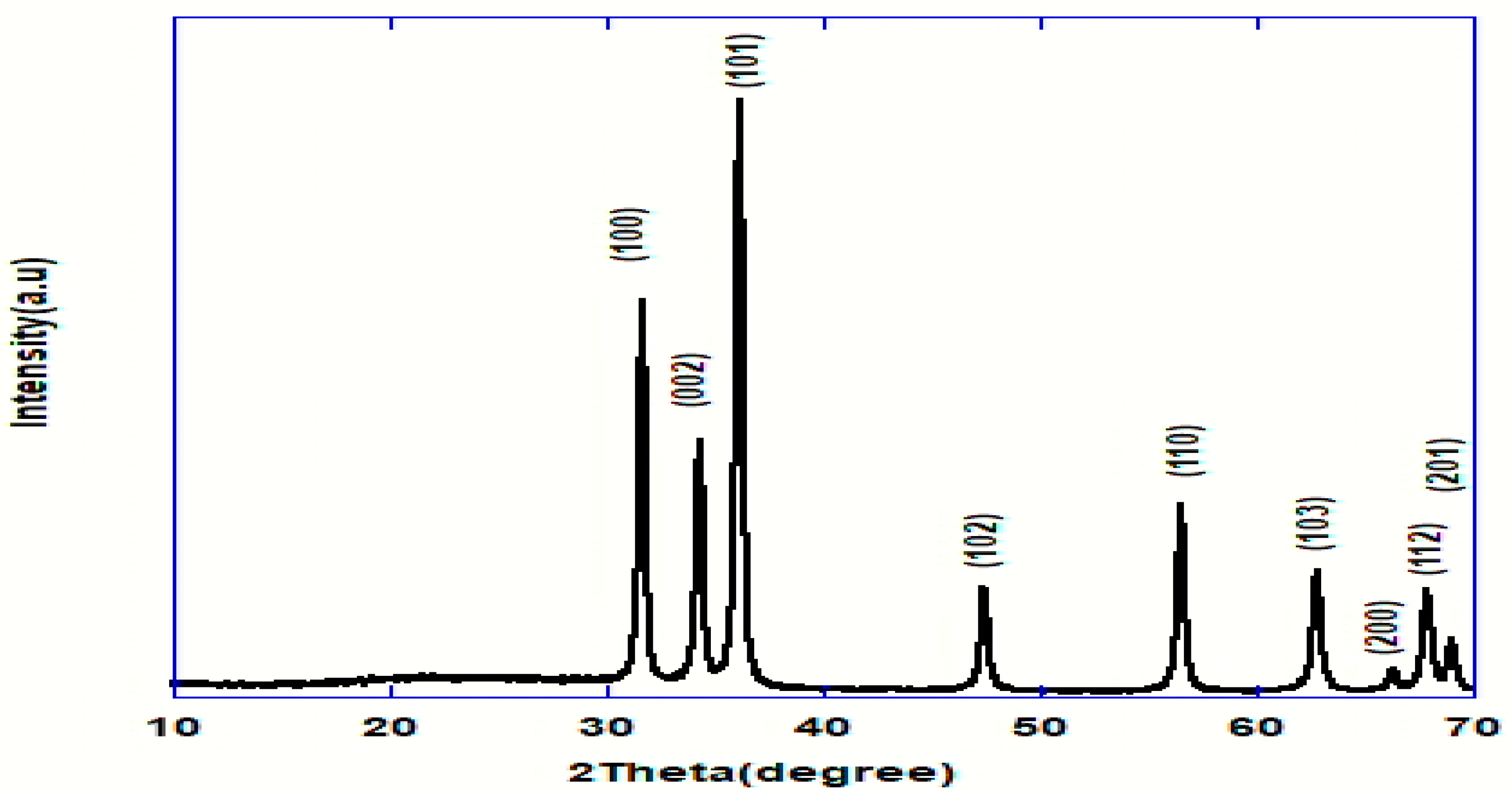
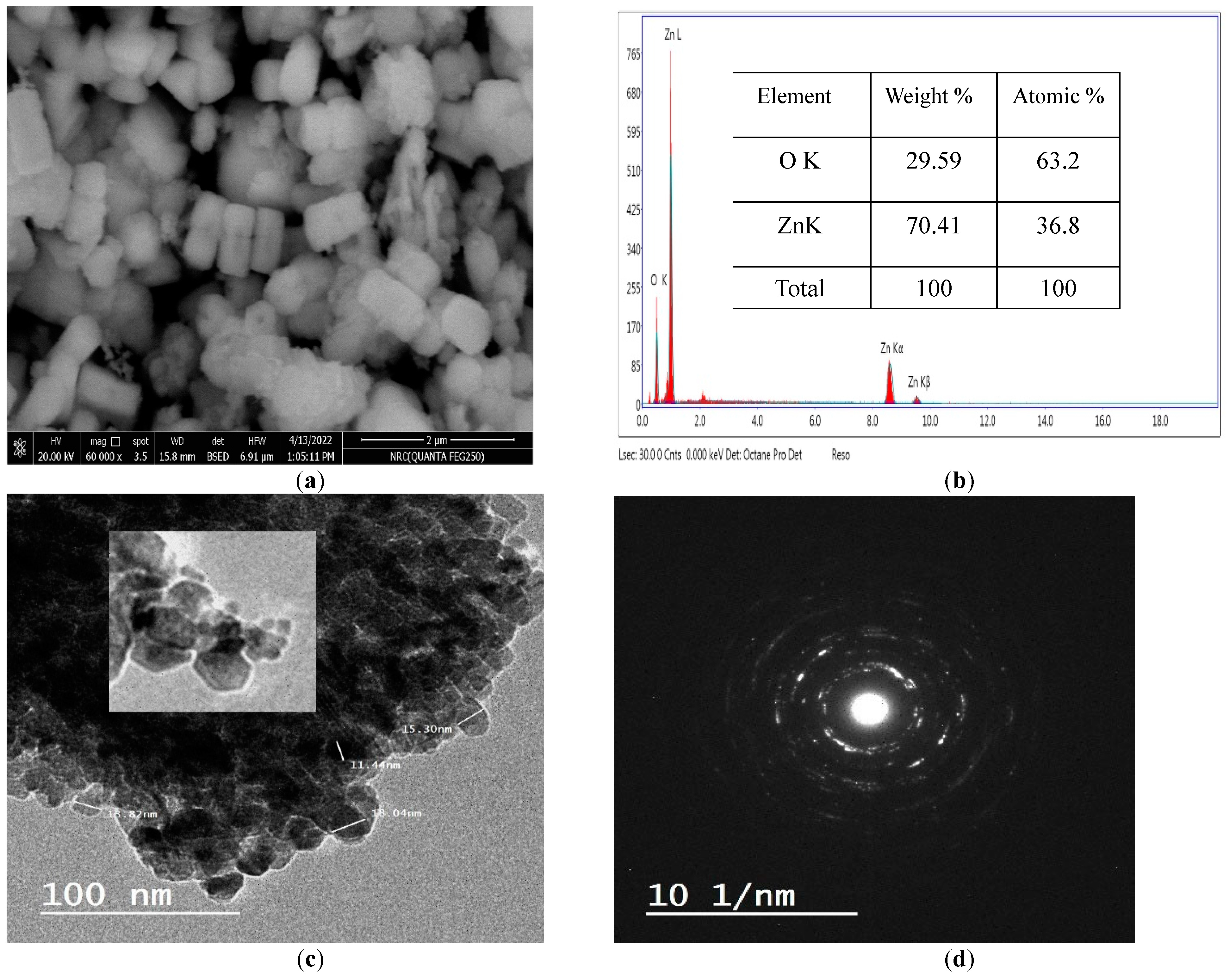

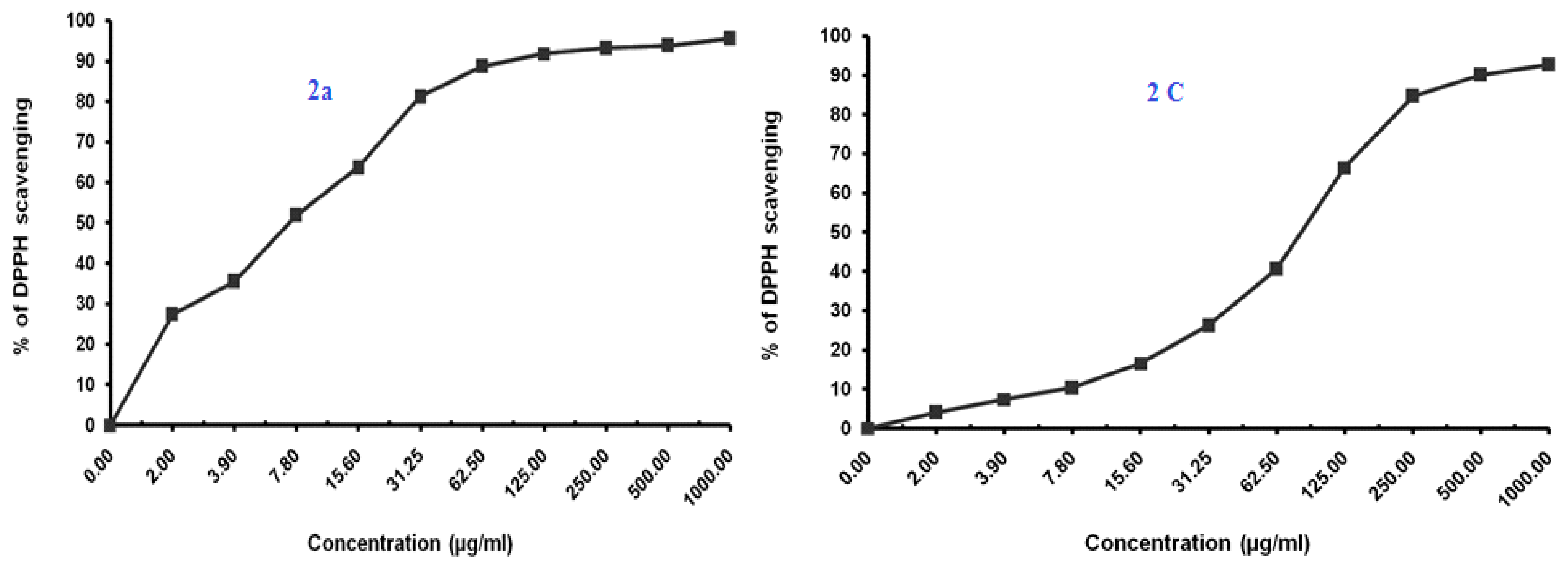
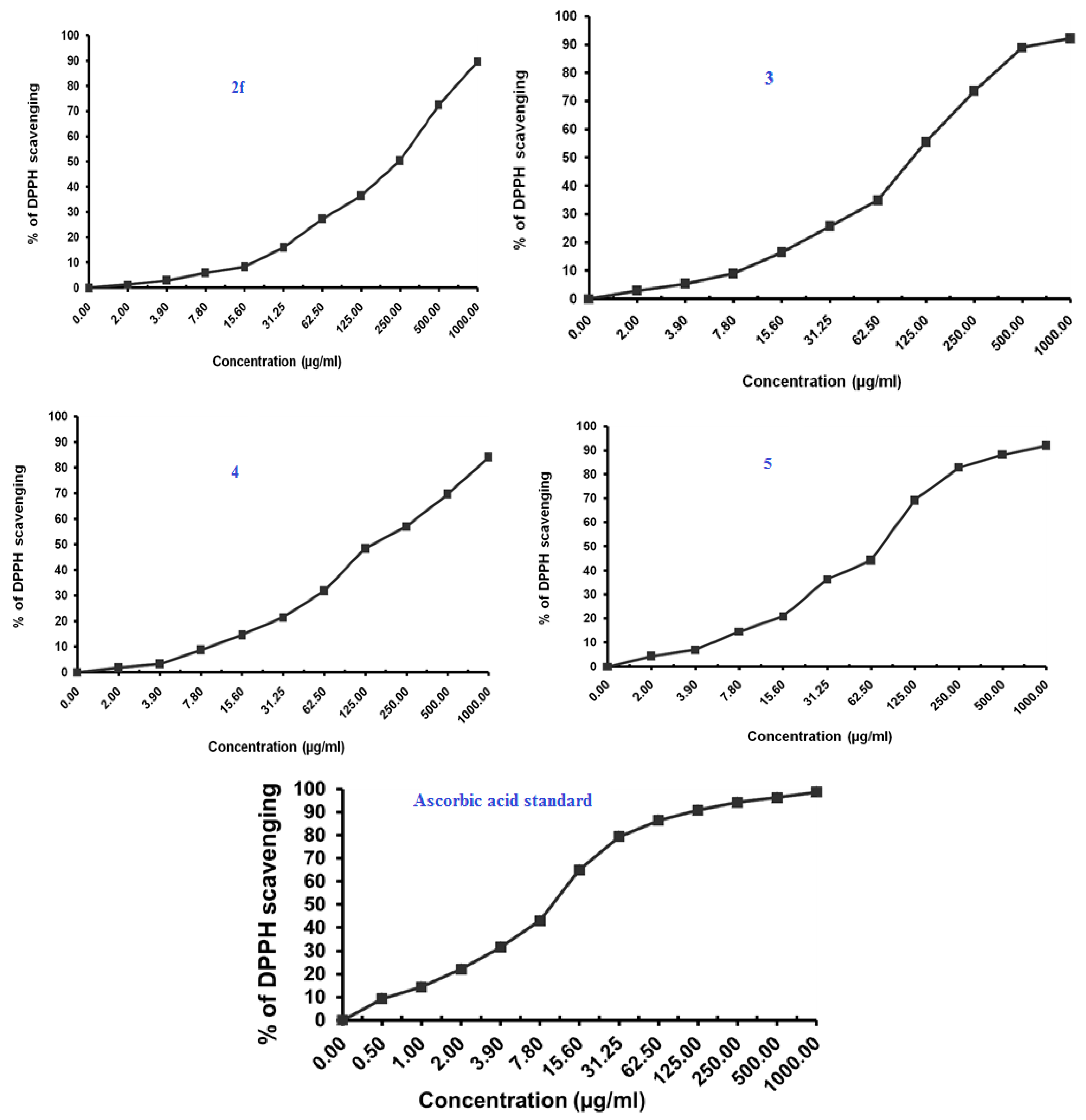
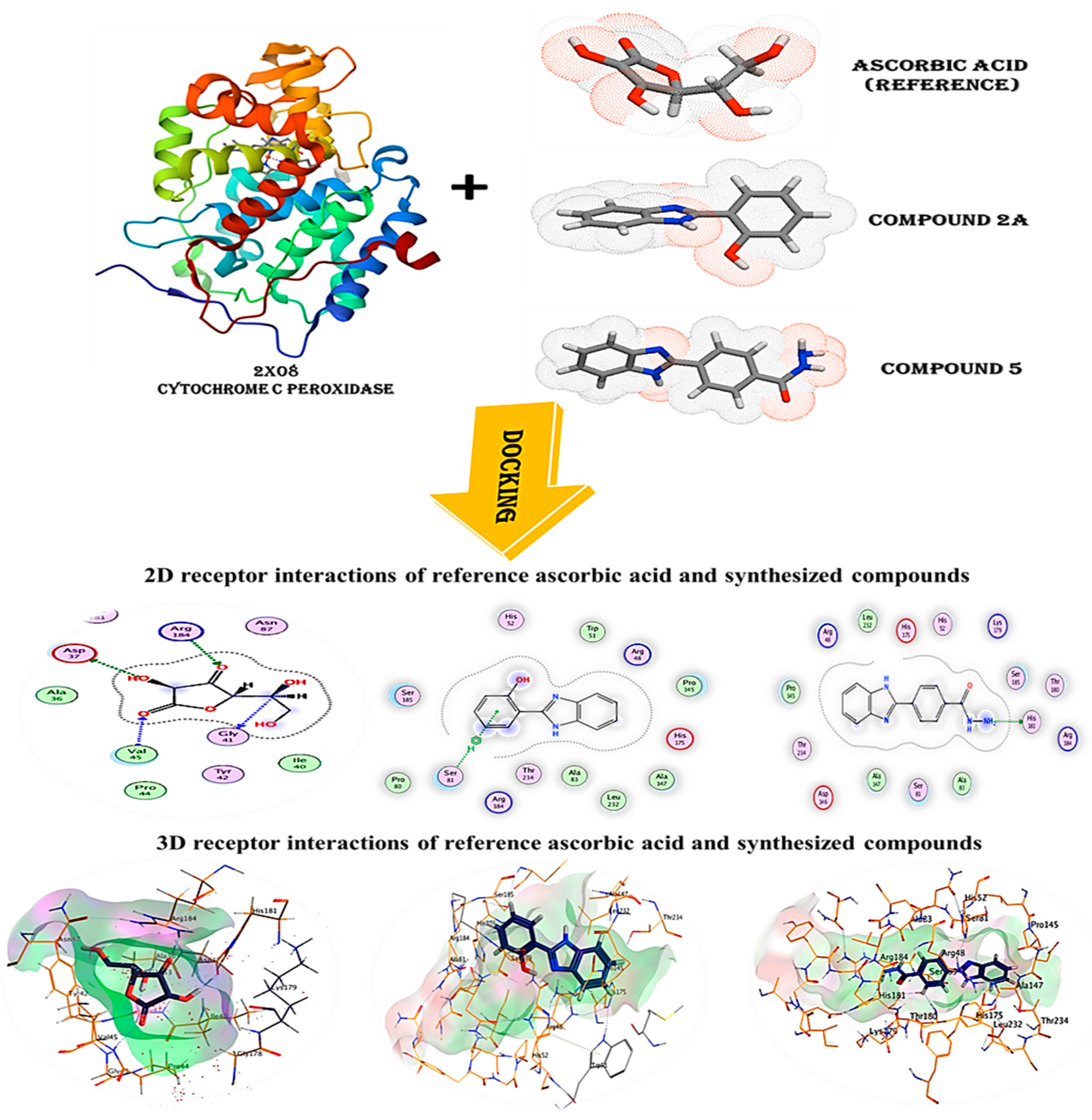


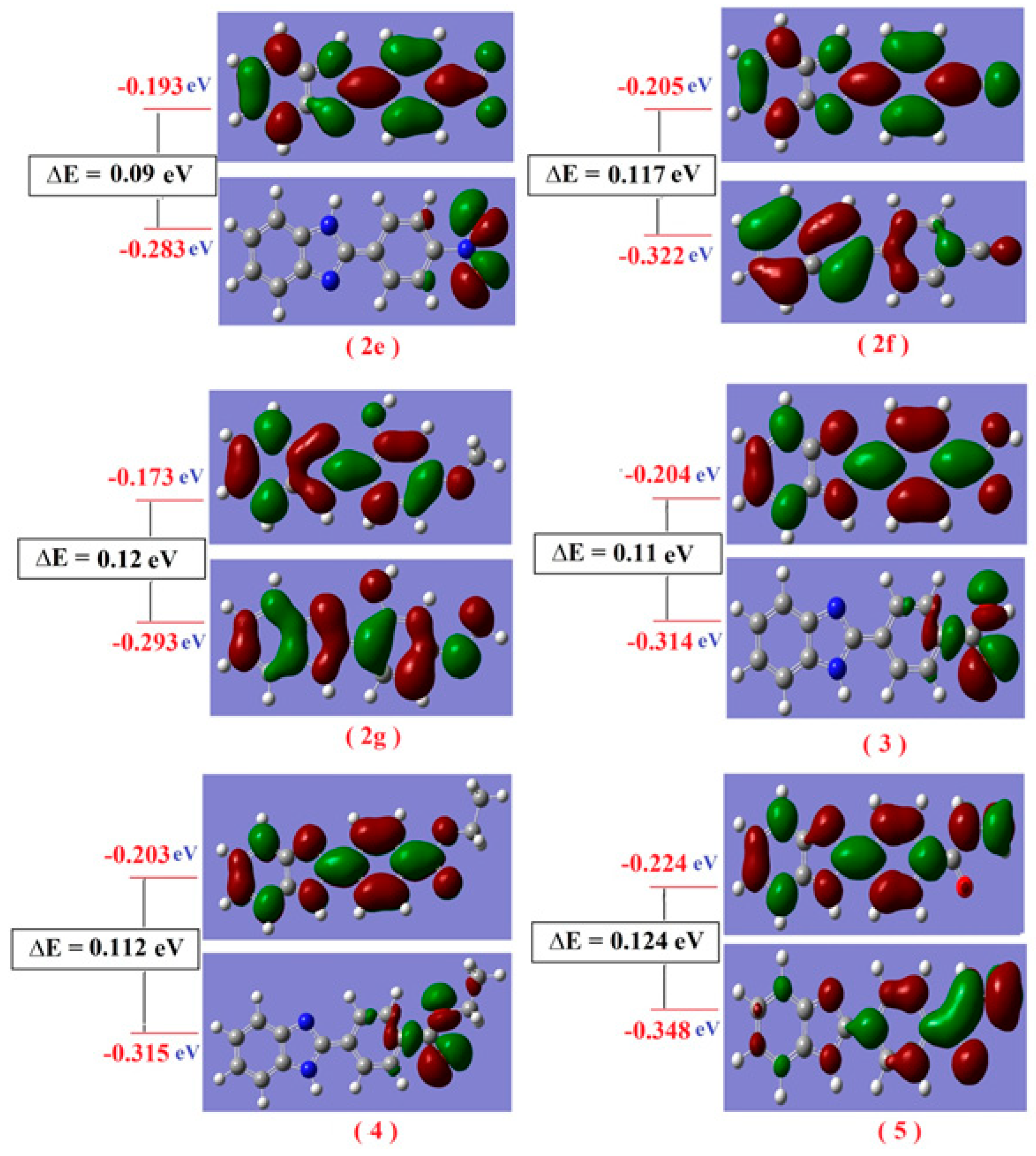
| Entry | Solvent | Catalysis (mol) | Temp (°C) | Time (h) | Yield (%) | Ref. |
|---|---|---|---|---|---|---|
| 1 | EtOH | TiO2(nano) (0.02%) | 70 °C | 2 | 86% | This work |
| 2 | EtOH | ZnO(nano) (0.02%) | 70 °C | 2 | 92% | This work |
| 3 | Toluene | p-TsOH | 80 °C | 2 | 81% | [19] |
| 4 | EtOH | PSA | r.t | 30 min | 85% | [20] |
| % Inhibition of DPPH Free Radical at Different Concentrations | |||||||||||
|---|---|---|---|---|---|---|---|---|---|---|---|
| Compds | 2 (µg/mL) | 3.9 (µg/mL) | 7.8 (µg/mL) | 15.6 (µg/mL) | 31.25 (µg/mL) | 62.5 (µg/mL) | 125 (µg/mL) | 250 (µg/mL) | 500 (µg/mL) | 1000 (µg/mL) | IC50 |
| 2a | 27.41 | 35.50 | 51.89 | 63.76 | 81.24 | 88.75 | 91.86 | 93.21 | 93.88 | 95.63 | 7.35 |
| 2c | 4.8 | 7.39 | 10.34 | 16.58 | 26.23 | 40.61 | 44.45 | 84.73 | 90.13 | 92.82 | 85.21 |
| 2f | 1.23 | 2.85 | 5.91 | 8.23 | 15.96 | 27.18 | 36.40 | 50.38 | 72.54 | 89.75 | 246.60 |
| 3 | 2.86 | 5.37 | 8.94 | 16.45 | 25.60 | 34.87 | 55.49 | 73.62 | 89.05 | 92.18 | 108.35 |
| 4 | 1.74 | 3.28 | 8.72 | 14.59 | 21.53 | 31.76 | 48.45 | 57.12 | 69.75 | 84.06 | 147.34 |
| 5 | 4.31 | 6.89 | 14.63 | 20.82 | 36.29 | 44.15 | 69.23 | 82.75 | 88.24 | 91.89 | 77.07 |
| Ascorbic acid | 22.18 | 1.04 | 43.01 | 65.05 | 79.35 | 86.42 | 90.89 | 94.25 | 96.34 | 98.65 | 10.21 |
| Comp. | Score (Kcal/mol) | RMSD | Interacting Residues | ||
|---|---|---|---|---|---|
| Receptor Interactions | Distance (Å) | E (Kcal/mol) | |||
| Ascorbic acid | −7.0409 | 1.5912 | Asp37/H-donor Gly41/H-donor Val45/H-acceptor Arg184/H-acceptor | 2.58 2.68 2.81 2.74 | −4.90 −1.40 −2.90 −4.40 |
| 2a | −7.3817 | 1.4893 | Ser81/pi-H | 3.91 | −0.90 |
| 5 | −7.1462 | 2.0053 | His181/H-donor | 3. 39 | −1.20 |
| (a) | |||||||||
| Compound | miLogP | TPSA | n-Atoms | M.W. | nON | nOHNH | n-Violations | n-rotb | Volume |
| 2a | 3.28 | 48.91 | 16 | 210.24 | 3 | 2 | 0 | 1 | 188.29 |
| 5 | 1.93 | 83.80 | 19 | 252.28 | 5 | 4 | 0 | 2 | 222.95 |
| (b) | |||||||||
| Compound | GPCR Ligand | Ion Channel Modulator | Kinase Inhibitor | Nuclear Receptor Ligand | Protease Inhibitor | Enzyme Inhibitor | |||
| 2a | −0.10 | 0.10 | 0.11 | −0.25 | −0.47 | 0.16 | |||
| 5 | −0.16 | −0.48 | 0.15 | −0.64 | −0.24 | 0.07 | |||
Disclaimer/Publisher’s Note: The statements, opinions and data contained in all publications are solely those of the individual author(s) and contributor(s) and not of MDPI and/or the editor(s). MDPI and/or the editor(s) disclaim responsibility for any injury to people or property resulting from any ideas, methods, instructions or products referred to in the content. |
© 2023 by the authors. Licensee MDPI, Basel, Switzerland. This article is an open access article distributed under the terms and conditions of the Creative Commons Attribution (CC BY) license (https://creativecommons.org/licenses/by/4.0/).
Share and Cite
Mohammed, S.M.; Shehab, W.S.; Emwas, A.-H.M.; Jaremko, M.; Abdellattif, M.H.; Zordok, W.A.; Tantawy, E.S. Eco-Friendly Synthesis of 1H-benzo[d]imidazole Derivatives by ZnO NPs Characterization, DFT Studies, Antioxidant and Insilico Studies. Pharmaceuticals 2023, 16, 969. https://doi.org/10.3390/ph16070969
Mohammed SM, Shehab WS, Emwas A-HM, Jaremko M, Abdellattif MH, Zordok WA, Tantawy ES. Eco-Friendly Synthesis of 1H-benzo[d]imidazole Derivatives by ZnO NPs Characterization, DFT Studies, Antioxidant and Insilico Studies. Pharmaceuticals. 2023; 16(7):969. https://doi.org/10.3390/ph16070969
Chicago/Turabian StyleMohammed, Samar M., Wesam S. Shehab, Abdul-Hamid M. Emwas, Mariusz Jaremko, Magda H. Abdellattif, Wael A. Zordok, and Eman S. Tantawy. 2023. "Eco-Friendly Synthesis of 1H-benzo[d]imidazole Derivatives by ZnO NPs Characterization, DFT Studies, Antioxidant and Insilico Studies" Pharmaceuticals 16, no. 7: 969. https://doi.org/10.3390/ph16070969
APA StyleMohammed, S. M., Shehab, W. S., Emwas, A.-H. M., Jaremko, M., Abdellattif, M. H., Zordok, W. A., & Tantawy, E. S. (2023). Eco-Friendly Synthesis of 1H-benzo[d]imidazole Derivatives by ZnO NPs Characterization, DFT Studies, Antioxidant and Insilico Studies. Pharmaceuticals, 16(7), 969. https://doi.org/10.3390/ph16070969








